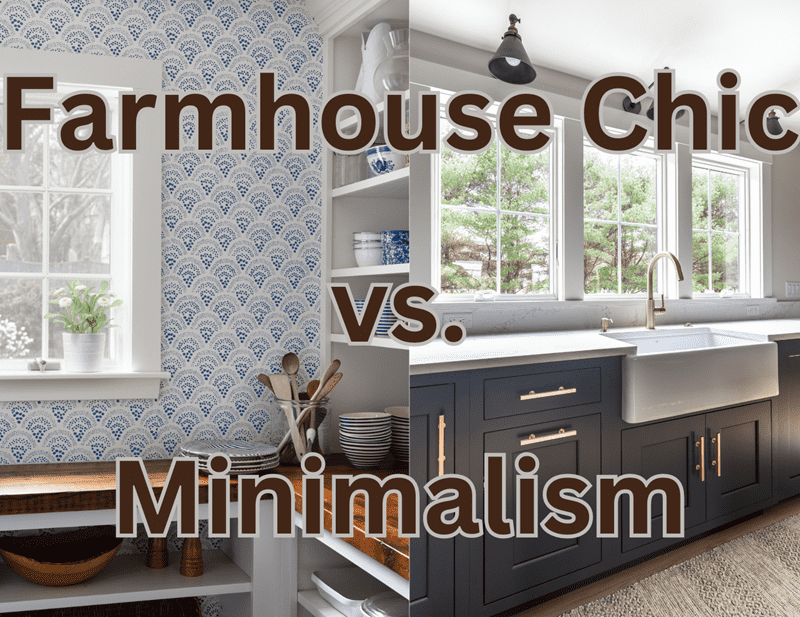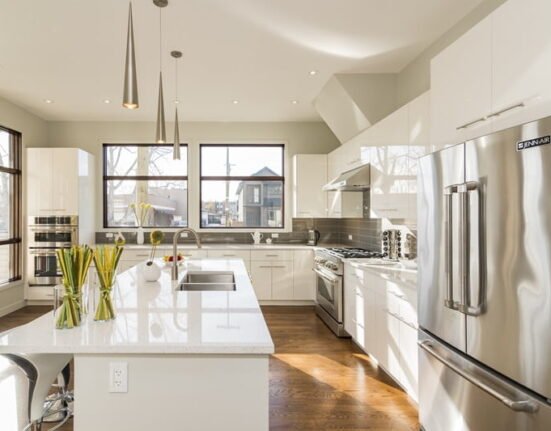Interior design plays a pivotal role in shaping the ambiance and functionality of our living spaces. Among the myriad styles available, Farmhouse Chic and Minimalist Design have gained significant popularity for their unique approaches to creating aesthetically pleasing environments. This blog aims to explore and compare these two distinctive styles, providing valuable insights for design students, homeowners planning a remodel, and anyone interested in understanding these trends before engaging with a professional interior designer.
Farmhouse Chic is a design style that marries rustic charm with modern comfort, creating warm and inviting spaces that evoke a sense of nostalgia. This style often incorporates natural materials, vintage decor, and a muted color palette, making it a favorite for those who appreciate a cozy, lived-in feel.
In contrast, Minimalist Design emphasizes simplicity and functionality. Rooted in the “less is more” philosophy, this style strips down elements to their essentials, creating clean, uncluttered spaces. It often features neutral color schemes, high-quality materials, and open layouts, making it ideal for those who prefer a serene and orderly environment.
This article will delve into the historical backgrounds, key characteristics, and practical applications of both styles, providing a comprehensive guide for anyone looking to choose the right aesthetic for their space.
Historical Background and Evolution
Farmhouse Chic Style
Origins and Evolution The roots of Farmhouse Chic can be traced back to rural Europe, particularly in the 16th and 17th centuries, where farmhouses were built primarily for practicality and functionality. These homes used locally sourced materials like wood and stone, emphasizing durability and comfort. The style was brought to North America by European settlers and became especially prominent during the colonial period and the westward expansion of the 19th century.
As time progressed, the Industrial Revolution introduced new materials and ideas, further influencing farmhouse aesthetics. This evolution included adopting elements from various architectural styles, such as Georgian and neoclassical, which were integrated into the farmhouse’s design. These homes started featuring more decorative elements, though they retained their fundamental emphasis on comfort and practicality.
Modern Farmhouse The contemporary revival of this style, often termed “Modern Farmhouse,” owes much of its popularity to the work of Chip and Joanna Gaines on HGTV’s Fixer Upper. They popularized features like shiplap walls, open shelving, and the use of reclaimed wood, blending the rustic elements of traditional farmhouses with sleek, modern touches. This modern take maintains the warmth and charm of the original farmhouse style but integrates it with modern amenities and design sensibilities, making it a popular choice in both rural and urban settings.
Minimalist Design
Origins and Development Minimalist Design emerged in the mid-20th century as a reaction against the overly ornate styles that preceded it. Influenced by modern art movements such as De Stijl and Bauhaus, as well as Japanese Zen philosophy, Minimalism sought to distill design down to its most essential elements. The movement emphasized simplicity, functionality, and the belief that “less is more,” rejecting unnecessary ornamentation in favor of clean lines and open spaces.
Philosophical Foundations At its core, Minimalism is about creating spaces that are not only aesthetically pleasing but also functional and uncluttered. This design ethos aligns with a broader cultural shift towards mindfulness and simplicity, reflecting a desire to strip away excess and focus on what truly matters. The minimalist approach often involves a monochromatic color palette, high-quality materials like glass and steel, and a focus on light and space to create a serene environment.
Cultural Influence and Popularity Minimalist Design has been widely adopted in various forms, from architecture to interior design. Its appeal lies in its versatility and timelessness, making it suitable for a range of applications, from small urban apartments to expansive modern homes. The style’s emphasis on simplicity and quality resonates particularly with young professionals and urban dwellers who prioritize efficiency and aesthetic.
Key Characteristics and Elements
Farmhouse Chic
Core Elements Farmhouse Chic is characterized by its blend of rustic and contemporary elements, creating a warm and inviting atmosphere. This style often features:
- Natural Materials: A hallmark of Farmhouse Chic is the use of natural materials such as wood, stone, and metal. Reclaimed wood is particularly popular, often used in flooring, furniture, and architectural details like exposed beams.
- Decorative Features: This style includes vintage-inspired decor, such as shiplap walls, barn doors, and antique lighting fixtures. Accessories like wire baskets, mason jars, and weathered signs add a nostalgic touch.
- Comfort and Practicality: Furniture in Farmhouse Chic designs is typically large and comfortable, prioritizing function. Pieces often have distressed finishes, giving them a well-worn, lived-in look.
Color Palette The color palette in Farmhouse Chic interiors tends to be neutral and muted. Common colors include whites, creams, soft grays, and earthy tones like sage green and warm browns. These colors create a calming and cozy environment, allowing the natural materials and textures to stand out.
Minimalist Design
Core Elements Minimalist Design focuses on simplicity and functionality, with an emphasis on creating uncluttered and open spaces. Key characteristics include:
- Clean Lines and Open Spaces: Minimalist interiors feature clean, straight lines and a lack of ornate details. The design often incorporates large windows and open floor plans to maximize natural light and create a sense of spaciousness.
- High-Quality Materials: The minimalist approach values quality over quantity, often using high-quality materials like marble, glass, and polished wood. These materials are used in a restrained manner, ensuring that each piece serves a purpose.
- Functional Furniture: Furniture in minimalist spaces is typically sleek and streamlined, often with multifunctional purposes. The design avoids excessive decoration, instead highlighting the beauty of the materials and the craftsmanship.
- Color Palette: Minimalist interiors generally employ a monochromatic color scheme, dominated by whites, blacks, and grays. Occasionally, bold accent colors are used sparingly to create visual interest. This neutral palette helps to create a calm and orderly environment, emphasizing the simplicity of the design.
Practical Applications in Interior Design
Furniture and Decor
Farmhouse Chic In Farmhouse Chic interiors, furniture is chosen for its comfort and charm. Key pieces often include large farmhouse tables, slipcovered sofas, and upholstered chairs. The style embraces a mix of old and new, blending vintage pieces with modern elements to create a cohesive look. Accessories play a significant role, with items like antique clocks, rustic chandeliers, and handcrafted items adding personality and warmth.
Minimalist Design Minimalist interiors focus on essential pieces that are functional and aesthetically pleasing. Furniture is typically modern and understated, with an emphasis on clean lines and simple forms. Storage solutions are cleverly integrated to maintain a clutter-free environment, and decorative elements are minimal, often limited to a few carefully chosen art pieces or statement furniture.
Space Utilization and Layout
Farmhouse Chic Farmhouse Chic interiors often feature open floor plans, which help to create a sense of spaciousness and flow. Kitchens and living areas are designed to be the heart of the home, often featuring large islands, open shelving, and ample seating to encourage gatherings. Practical storage solutions, such as built-in cabinets and wicker baskets, help keep the space organized while maintaining its rustic charm.
Minimalist Design In Minimalist Design, space is used thoughtfully, with a focus on maximizing functionality. Open layouts are common, with a seamless transition between different areas of the home. Minimalist interiors often feature built-in furniture and hidden storage solutions to maintain a clean and streamlined appearance. The design emphasizes the use of negative space, allowing each element to breathe and stand out.
Both Farmhouse Chic and Minimalist Design offer unique approaches to interior design, each with its distinct characteristics and appeal. Understanding these key elements and practical applications can help you choose the style that best fits your personal taste and lifestyle needs. Whether you’re drawn to the cozy warmth of Farmhouse Chic or the serene simplicity of Minimalist Design, both styles offer versatile options for creating beautiful and functional living spaces.
Popularity and Cultural Influence
Global and Demographic Appeal
Farmhouse Chic Farmhouse Chic has a broad appeal across various demographics and regions, particularly in North America and parts of Europe. Its popularity surged with the influence of television shows like HGTV’s Fixer Upper, which brought the style into the mainstream. The style’s emphasis on comfort, nostalgia, and a lived-in feel makes it particularly attractive to families and individuals who appreciate a cozy, welcoming home environment.
This style is popular in both urban and rural areas. In cities, homeowners and designers often blend Farmhouse Chic elements with modern urban aesthetics, creating a unique hybrid style that retains the warmth and charm of the farmhouse look. The style is favored by those who enjoy a blend of rustic charm and modern amenities, offering a sense of history and simplicity in the midst of contemporary life.
Minimalist Design Minimalist Design enjoys widespread popularity worldwide, especially in urban centers where space is often limited. Its clean, uncluttered approach is particularly appealing to young professionals, tech-savvy individuals, and those who prefer a streamlined, efficient lifestyle. The minimalist ethos of “less is more” resonates with a growing cultural shift towards sustainability and mindful living, making it popular among eco-conscious consumers.
This style’s global appeal is further enhanced by its adaptability. Minimalist principles can be applied in various cultural contexts, making it a versatile choice for interior design. It is especially popular in metropolitan areas where people often seek to maximize their living space’s functionality and aesthetic appeal.
Influential Designers and Media
Farmhouse Chic One of the most influential figures in the popularity of Farmhouse Chic is Joanna Gaines, co-host of Fixer Upper. Her design aesthetic, characterized by the use of shiplap, reclaimed wood, and a blend of vintage and modern elements, has become synonymous with the modern farmhouse look. Other designers and brands have also embraced this style, further cementing its place in contemporary interior design.
Minimalist Design Minimalism has been shaped by several key figures in the design and architectural world. Ludwig Mies van der Rohe, a pioneer of modern architecture, is often credited with the famous phrase “less is more,” which encapsulates the minimalist ethos. Contemporary designers like John Pawson and brands like Muji have also played significant roles in popularizing minimalist interiors, focusing on simplicity, functionality, and quality.
How to Choose the Right Style for Your Space
Choosing between Farmhouse Chic and Minimalist Design depends largely on personal preferences, lifestyle, and the specific needs of your living space. Here are some considerations to help you decide:
Lifestyle Considerations
- Farmhouse Chic: Ideal for those who value comfort, nostalgia, and a cozy atmosphere. It’s perfect for families and individuals who enjoy traditional elements mixed with modern conveniences.
- Minimalist Design: Suited for people who prefer simplicity, efficiency, and a clutter-free environment. It’s an excellent choice for urban dwellers, young professionals, and anyone looking to embrace a more mindful lifestyle.
Personal Aesthetic
- Farmhouse Chic: Appeals to those who appreciate rustic charm, vintage decor, and a warm, inviting home. It’s great for creating a space that feels lived-in and personalized.
- Minimalist Design: Attracts those who enjoy clean lines, modern aesthetics, and a focus on quality over quantity. It’s ideal for creating a calm, serene space that emphasizes functionality.
Combining Elements from Both Styles
Blending elements of Farmhouse Chic and Minimalist Design can create a unique and balanced look. Here are some tips:
- Use neutral color palettes from both styles to create a cohesive backdrop.
- Incorporate functional, minimalist furniture with rustic, farmhouse-inspired decor like reclaimed wood accents or vintage accessories.
- Maintain a clutter-free environment while adding cozy elements such as soft textiles and warm lighting.
Conclusion
Farmhouse Chic and Minimalist Design offer two distinct yet versatile approaches to interior design. Farmhouse Chic is all about creating a cozy, welcoming space with a blend of rustic and modern elements, while Minimalist Design focuses on simplicity, functionality, and the beauty of essential forms.
Both styles have broad appeal and can be adapted to suit various tastes and lifestyles. Whether you’re drawn to the nostalgic charm of Farmhouse Chic or the clean, serene lines of Minimalism, understanding the key characteristics and practical applications of these styles can help you create a space that reflects your personal aesthetic and meets your needs.
For those planning a remodel or redesign, exploring these styles further can provide valuable inspiration and direction. And for students and aspiring designers, studying the nuances of Farmhouse Chic and Minimalist Design can deepen your understanding of contemporary interior design trends. Whatever your design journey, these styles offer a wealth of possibilities to explore and enjoy.










